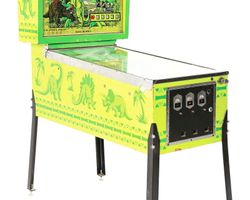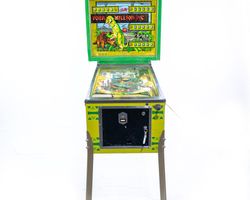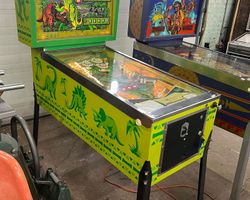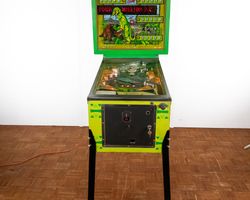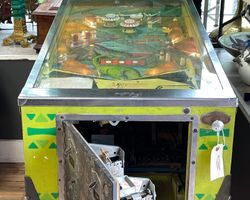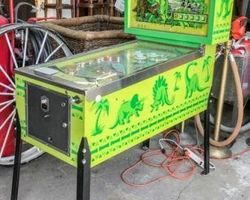Four Million B.C.
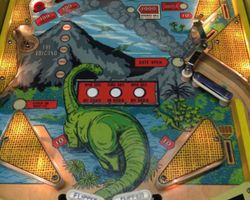
Average Prices: USD $400 to $1,500
Produced: May, 1971
Production Run: 3,550 units
Machine Type: Electro-mechanical
Players: 4
Design by: Ted Zale
Art by: Dick White
Bally Manufacturing Corporation introduced "Four Million B.C." to arcades and homes in May 1971, an electro-mechanical (EM) pinball machine that transported players to a primeval world teeming with prehistoric creatures and cave-dwelling humans. The game’s conceptualization, design, artwork, animation, and mechanical engineering were attributed to Ted Zale, an extensive list of credits reflecting a singular vision for the machine. Dick White contributed additional artwork, bringing the ancient world to life on the playfield and backglass. Production figures totaled 3,550 units, a respectable run for its time, cementing its presence in the market. A distinct version was also manufactured for Germany, sharing the same project number and release date, differing primarily in its schematic part numbers, indicating Bally's intent for international distribution. While some observers drew parallels between its dinosaur theme and popular culture like the 1966 film One Million Years B.C., Bally made no explicit connection. However, the game’s title did echo Midway’s 1968 gun game, 1 Million B.C., suggesting a general zeitgeist for prehistoric themes in entertainment.
"Four Million B.C." distinguished itself with a suite of features that were advanced for an EM machine of its era. Central to its unique play experience were the zipper flippers, which, unlike standard flippers, could close together at the bottom of the playfield, creating a solid barrier to prevent ball drains. This mechanism provided both strategic advantages and an added layer of challenge during gameplay, particularly during multiball phases. The machine also featured an innovative multiball mode, allowing for two or three balls in play simultaneously, a considerable rarity and source of excitement for a 1971 EM title. A captive ball walker mechanism, which carried over its status from game to game, added a novel progression element. Additionally, a kick-out hole with a motorized Flash Bonus offered variable awards, ensuring unpredictability and replayability. A particularly clever ramp served as the basis for a skill shot, where players could earn significant points by gently plunging the ball just to the ramp's apex, allowing it to roll back down rather than over. The inclusion of a ball return gate, feeding the ball back to the shooter lane, and a left outlane kicker provided further opportunities for extended play and strategic recovery.
The playfield of "Four Million B.C." is a visually striking and mechanically intricate landscape, dominated by a vibrant green aesthetic that permeates the cabinet and backglass. The lower playfield is defined by the two zipper flippers, which, when engaged, transform the typically open outlane area into a constrained channel, forcing precise shots. Above the flippers, a trio of pop bumpers, complemented by two mushroom bumpers and slingshots, create a chaotic but engaging central zone. Strategic rollover buttons and standup targets are peppered across the field, offering points and activating features. Key interactive elements include a captive ball kick-out hole, often referred to as the "volcano" due to its thematic integration, which is crucial for initiating multiball. Another ball locking mechanism, a trough often called the "tar pit," also contributes to securing balls for multiball. The upper right portion of the playfield houses the four-step captive ball alley, a distinct feature where the ball advances through a series of steps before returning to play, with its progress carrying over between games. The artwork, primarily by Dick White, depicts vivid scenes of dinosaurs, cavemen, and prehistoric flora, reinforcing the theme. While the backglass art, particularly a dinosaur fight scene, garnered praise for its dynamism, the playfield plastics, sometimes described as having a "burlap" or "basketweave" texture, drew mixed reactions, with some finding them less visually appealing.
Gameplay dynamics in "Four Million B.C." revolved around accumulating points and, most significantly, achieving multiball. The scoring system allowed for a maximum displayed score of 99,990 points per player. Players aimed to lock balls in the "volcano" kick-out hole and "tar pit" trough to trigger the multiball mode, a primary objective that delivered exhilarating, fast-paced action. During multiplayer games, the ability to "steal" locked balls from opponents added a layer of competitive strategy. The aforementioned skill shot, requiring a delicate plunger touch to land the ball on the ramp’s return path for a high score, rewarded player finesse. The left outlane kicker provided a valuable second chance for balls heading for a drain, while the ball return gate could loop the ball back to the shooter lane, allowing for strategic replays of the skill shot. Despite the relatively simple sound design, primarily consisting of a bell and knocker, the constant action and the thrill of multiball maintained player engagement. Mastering the unique behavior of the zipper flippers was a core gameplay challenge, as their closed position changed shot angles and rebound trajectories, dictating different strategies compared to machines with traditional flipper layouts.
"Four Million B.C." garnered a largely positive reception from the pinball community, often celebrated as a pioneering EM machine that pushed the boundaries of its era. Its strengths were frequently cited as its innovative features, particularly the inclusion of multiball, which was revolutionary for 1971. The distinctive zipper flippers, while sometimes challenging for precise shot control, were recognized for offering a unique gameplay experience. The ramp skill shot was also consistently praised for its clever design and rewarding nature. The prehistoric theme and artwork, especially the vibrant backglass, were a significant draw, contributing to the machine’s distinct identity. Many players found the gameplay to be fast, addictive, and consistently exciting, especially during multiball sequences. The machine's collectibility is well-established, often considered part of Bally's influential "Big Three" zipper flipper games and a significant piece of pinball history due to its forward-thinking innovations.
However, the machine was not without its criticisms. Some players found that the core gameplay loop, centered around locking balls for multiball, could become somewhat repetitive once the initial novelty of its features subsided. The zipper flippers, while innovative, were a point of division; some found them difficult to control for accurate shots, preferring the predictability of traditional posts. A lack of more complex sequences of targets or objectives beyond the primary multiball goal was occasionally noted, contributing to the perception of shallower gameplay for some. The plastic artwork on the playfield, with its "burlap sack" design, was a frequent point of contention, described by some as visually unappealing, although others found it grew on them. Furthermore, as an EM machine, its sound design was basic, limited to a bell and knocker, which some compared unfavorably to machines with more engaging chime units. Despite these points, "Four Million B.C." maintained a strong reputation, recognized for its daring feature set and enduring appeal, leaving a lasting mark on the development of pinball design.
Sponsored Links
 Ebay Listings
Ebay Listings
 Auction Results
Auction Results
| Cost | Location | Date |
|---|---|---|
| USD $1,500 |  United States United States |
07 February, 2025 |
| GBP £999 |  United Kingdom United Kingdom |
20 December, 2024 |
| EUR €1,500 |  Nordrhein-Westfalen, Germany Nordrhein-Westfalen, Germany |
04 December, 2024 |
| USD $250 |  New York, United States New York, United States |
01 December, 2024 |
| USD $1,200 |  Illinois, United States Illinois, United States |
15 November, 2024 |
| USD $2,200 |  Florida, United States Florida, United States |
19 March, 2024 |
| EUR €985 |  Hessen, Germany Hessen, Germany |
09 February, 2024 |
| USD $2,000 |  Michigan, United States Michigan, United States |
09 February, 2024 |
| USD $1,300 |  Illinois, United States Illinois, United States |
03 February, 2024 |
| USD $1,300 |  Illinois, United States Illinois, United States |
03 February, 2024 |


Private Policy · Search Website · Contact Us
As an eBay Partner, we may earn a commission from qualifying purchases made through links on this site, at no additional cost to you.
All trademarks and copyrighted materials remain property of their respective owners. All other content copyright 2007 - 2025 Pinpedia.

